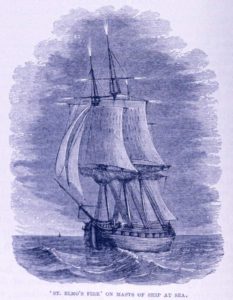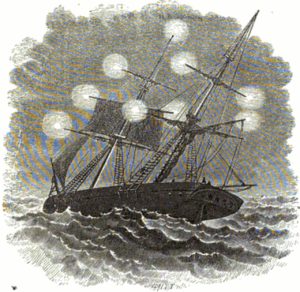
St. Elmo’s fire (also St. Elmo’s light[1] Elias’s Fire and Helen’s Light.[2])
is an electrical weather phenomenon in which luminous plasma is created by a coronal discharge originating from a grounded object in an atmospheric electric field (such as those generated by thunderstorms or thunderstorms created by a volcanic explosion).
St. Elmo’s fire is named after St. Erasmus of Formiae (also called St. Elmo), the patron saint of sailors. The phenomenon sometimes appeared on ships at sea during thunderstorms, and was regarded by sailors with religious awe, accounting for the name.
Ball lightning is often erroneously identified as St. Elmo’s fire. They are separate and distinct meteorological phenomena.[3]
Observation
Physically, St. Elmo’s fire is a bright blue or violet glow, appearing like fire in some circumstances, from tall, sharply pointed structures such as lightning rods, masts, spires and chimneys, and on aircraft wings. St. Elmo’s fire can also appear on leaves, grass, and even at the tips of cattle horns.[4] Often accompanying the glow is a distinct hissing or buzzing sound.
In 1750, Benjamin Franklin hypothesized that a pointed iron rod during a lightning storm would light up at the tip, similar in appearance to St. Elmo’s fire.[5][6]
It said that it might be the same effect on pointed metal objects, like the sharp edge of a pan or the tips of a fork, which are placed in a working microwave.
Scientific explanation
Although referred to as “fire”, St. Elmo’s fire is, in fact, plasma. The electric field around the object in question causes ionization of the air molecules, producing a faint glow easily visible in low-light conditions. Approximately 1,000 – 30,000 volts per centimeter is required to induce St. Elmo’s fire; however, this number is greatly dependent on the geometry of the object in question. Sharp points tend to require lower voltage levels to produce the same result because electric fields are more concentrated in areas of high curvature, thus discharges are more intense at the end of pointed objects.[7]
Saint Elmo’s fire and normal sparks both can appear when high electrical voltage affects a gas. St. Elmo’s fire is seen during thunderstorms when the ground below the storm is electrically charged, and there is high voltage in the air between the cloud and the ground. The voltage tears apart the air molecules and the gas begins to glow.
The nitrogen and oxygen in the Earth’s atmosphere causes St. Elmo’s fire to fluoresce with blue or violet light; this is similar to the mechanism that causes neon lights to glow.[7]
Historical observations

In ancient Greece, the appearance of a single one was called Helena and two were called Castor and Pollux. Occasionally, it was associated with the Greek element of fire, as well as with one of Paracelsus‘s elementals, specifically the salamander, or, alternatively, with a similar creature referred to as an acthnici.[8]
Welsh mariners knew it as canwyll yr ysbryd (“spirit-candles”) or canwyll yr ysbryd glân (“candles of the Holy Ghost”), or the “candles of St. David“.[9]
References to St. Elmo’s fire, also known as “corposants” or “corpusants” from the Portuguese corpo santo[10] (“holy body”), can be found in the works of Julius Caesar (De Bello Africo, 47), Pliny the Elder (Naturalis Historia, book 2, par. 101) , Herman Melville, and Antonio Pigafetta‘s journal of his voyage with Ferdinand Magellan. St. Elmo’s fire was a phenomenon described in The Lusiads.
Robert Burton wrote of St. Elmo’s fire in his Anatomy of Melancholy: “Radzivilius, the Polonian duke, calls this apparition, Sancti Germani sidus; and saith moreover that he saw the same after in a storm, as he was sailing, 1582, from Alexandria to Rhodes”. This refers to the voyage made by Mikołaj Krzysztof “the Orphan” Radziwiłł in 1582-1584.
Charles Darwin noted the effect while aboard the Beagle. He wrote of the episode in a letter to J.S. Henslow that one night when the Beagle was anchored in the estuary of the Río de la Plata:
-
- “Everything is in flames, — the sky with lightning, — the water with luminous particles, and even the very masts are pointed with a blue flame.”[11]
St. Elmo’s fire is reported to have been seen during the Muslim Siege of Constantinople in 1453. It reportedly was seen emitting from the top of the Hippodrome. The Byzantines attributed it to a sign that the Christian God would soon come and destroy the invading Muslim army.
In Two Years Before the Mast, Richard Henry Dana, Jr. describes seeing a corposant in the southern Atlantic Ocean, however he may have been talking about ball lightning; as mentioned earlier it is often erroneously identified as St. Elmo’s fire: “There, directly over where we had been standing, upon the main top-gallant mast-head, was a ball of light, which the sailors name a corposant (corpus sancti), and which the mate had called out to us to look at. They were all watching it carefully, for sailors have a notion, that if the corposant rises in the rigging, it is a sign of fair weather, but if it comes lower down, there will be a storm.”[12]
Many Russian sailors have seen them throughout the years. To them, they are “Saint Nicholas” or “Saint Peter’s lights”.[9] They were also sometimes called St. Helen’s or St. Hermes’ fire, perhaps through linguistic confusion.[13]
St Elmo’s fire were also seen during the 1955 Great Plains tornado outbreak in Kansas and Oklahoma (US).[14]
Accounts of Magellan’s first circumnavigation of the globe refer to St. Elmo’s fire being seen around the fleet’s ships multiple times off the coast of South America. The sailors saw these as favorable omens.
Among the phenomena experienced on British Airways Flight 9 on 24 June 1982 were glowing light flashes along the leading edges of the aircraft, which were seen by both passengers and crew. This has been attributed to the Saint Elmo’s fire effect, caused by static electricity built up during the airplane’s passage through a cloud of volcanic ash.
Spectacular jet aircraft St. Elmo’s fire was observed and its optical spectrum recorded during a University of Alaska research flight over the Amazon in 1995 to study sprites.[15][16]
See also
References
- ↑ Darwin, Charles R., 1839, Narrative of the surveying voyages of His Majesty’s Ships Adventure and Beagle between the years 1826 and 1836, describing their examination of the southern shores of South America, and the Beagle’s circumnavigation of the globe. Journal and remarks. 1832-1836. London, Henry Colburn, p. 619. On page 44, Darwin says “On a second night we witnessed a splendid scene of natural fireworks; the mast-head and yard-arm ends shone with St. Elmo’s light; and the form of the vane could almost be traced, as if it had been rubbed with phosphorus.” See it also in The Complete Work of Charles Darwin Online
- ↑ Encyclopædia Americana (1838), (page 125)
- ↑ Barry, J.D. (1980a) Ball Lightning and Bead Lightning: Extreme Forms of Atmospheric Electricity. 8-9. New York and London: Plenum Press. ISBN 0-306-40272-6
- ↑ Heidorn, K., Ph.D. Weather Elements: The Fire of St. Elmo. Retrieved on July 2, 2007.
- ↑ Van Doren, Carl. Benjamin Franklin, The Viking Press, New York, 1938. p. 159. Quoted text from May 1750 letter published in “Gentleman’s Magazine” at http://www.math.tamu.edu/~stecher/489/Ben/science.shtml.[1]
- ↑ Additional reference may be made from Yale University’s The Papers of Benjamin Franklin collection at http://www.yale.edu/franklinpapers/index.html.[2]
- ↑ a b Scientific American. Ask The Experts: Physics. Retrieved on July 2, 2007.
- ↑ The Elements and Their Inhabitants [3]
- ↑ a b Folk-lore and folk-stories of Wales, The Sea, Lakes, Rivers and Wells, Marie Trevelyan, 1909.
- ↑ The American Heritage Dictionary
- ↑ Darwin Correspondence Project, Letter 178 — Darwin, C. R. to Henslow, J. S., [23 July –] 15 August [1832] [4]
- ↑ Dana, Richard Henry Jr., (1840) Two Years Before the Mast. Chapter 33.
- ↑ Will With A Wisp: John Brand (1777)
- ↑ Storm Electricity Aspects of the Blackwell/Udall Storm of 25 May 1955 – Don Burgess, University of Oklahoma (CIMMS)
- ↑ Wescott et al. (1996) “The optical spectrum of aircraft St. Elmo’s fire”, Geophys. Res. Lett., 23(25), pp 3687-3690.
- ↑ “Peru95 – sprite observations over the upper Amazon”
- ↑ Ower, John. The “Death-Fires”, the “Fire-Flags” and the Corposant in “The Rime of the Ancient Mariner”. Philological Quarterly, vol. 70 no. 2, p. 199-218. 1991